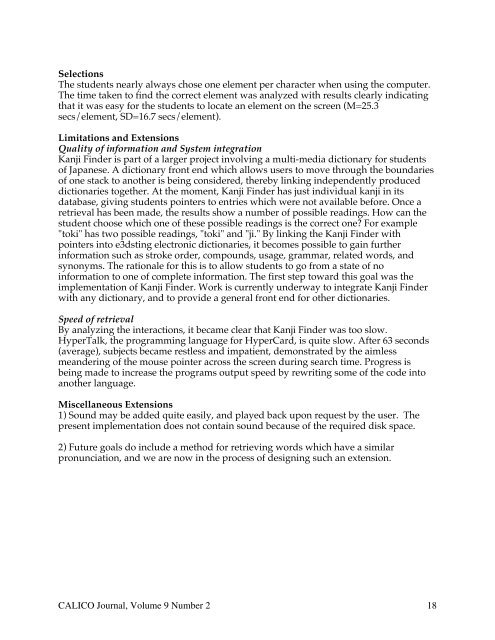Kanji Retrieval by Recursive Location of Elements Using HyperCard
Kanji Retrieval by Recursive Location of Elements Using HyperCard
Kanji Retrieval by Recursive Location of Elements Using HyperCard
Create successful ePaper yourself
Turn your PDF publications into a flip-book with our unique Google optimized e-Paper software.
Selections<br />
The students nearly always chose one element per character when using the computer.<br />
The time taken to find the correct element was analyzed with results clearly indicating<br />
that it was easy for the students to locate an element on the screen (M=25.3<br />
secs/element, SD=16.7 secs/element).<br />
Limitations and Extensions<br />
Quality <strong>of</strong> information and System integration<br />
<strong>Kanji</strong> Finder is part <strong>of</strong> a larger project involving a multi-media dictionary for students<br />
<strong>of</strong> Japanese. A dictionary front end which allows users to move through the boundaries<br />
<strong>of</strong> one stack to another is being considered, there<strong>by</strong> linking independently produced<br />
dictionaries together. At the moment, <strong>Kanji</strong> Finder has just individual kanji in its<br />
database, giving students pointers to entries which were not available before. Once a<br />
retrieval has been made, the results show a number <strong>of</strong> possible readings. How can the<br />
student choose which one <strong>of</strong> these possible readings is the correct one? For example<br />
"toki" has two possible readings, "toki" and "ji." By linking the <strong>Kanji</strong> Finder with<br />
pointers into e3dsting electronic dictionaries, it becomes possible to gain further<br />
information such as stroke order, compounds, usage, grammar, related words, and<br />
synonyms. The rationale for this is to allow students to go from a state <strong>of</strong> no<br />
information to one <strong>of</strong> complete information. The first step toward this goal was the<br />
implementation <strong>of</strong> <strong>Kanji</strong> Finder. Work is currently underway to integrate <strong>Kanji</strong> Finder<br />
with any dictionary, and to provide a general front end for other dictionaries.<br />
Speed <strong>of</strong> retrieval<br />
By analyzing the interactions, it became clear that <strong>Kanji</strong> Finder was too slow.<br />
HyperTalk, the programming language for <strong>HyperCard</strong>, is quite slow. After 63 seconds<br />
(average), subjects became restless and impatient, demonstrated <strong>by</strong> the aimless<br />
meandering <strong>of</strong> the mouse pointer across the screen during search time. Progress is<br />
being made to increase the programs output speed <strong>by</strong> rewriting some <strong>of</strong> the code into<br />
another language.<br />
Miscellaneous Extensions<br />
1) Sound may be added quite easily, and played back upon request <strong>by</strong> the user. The<br />
present implementation does not contain sound because <strong>of</strong> the required disk space.<br />
2) Future goals do include a method for retrieving words which have a similar<br />
pronunciation, and we are now in the process <strong>of</strong> designing such an extension.<br />
CALICO Journal, Volume 9 Number 2 18
















